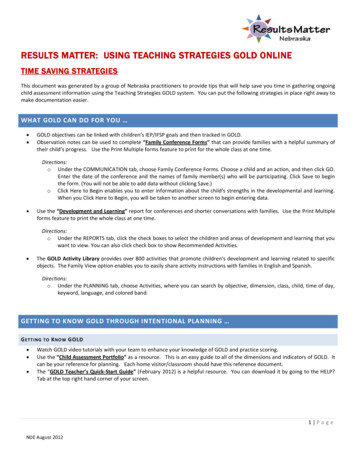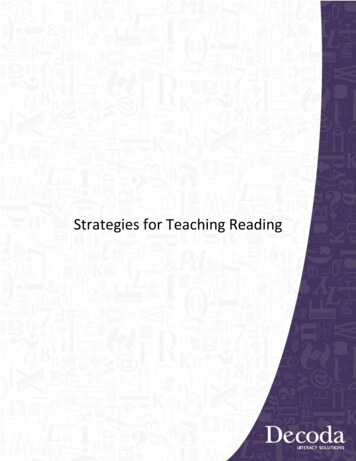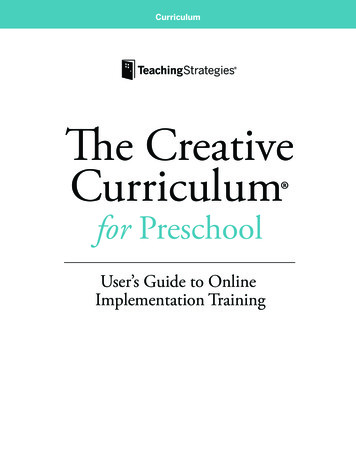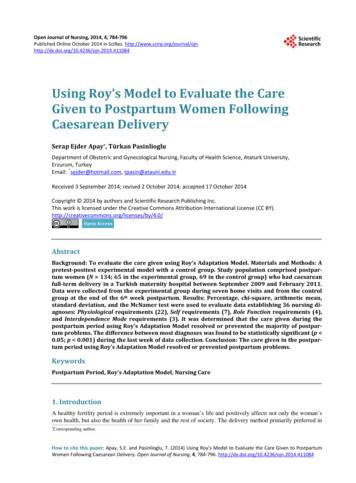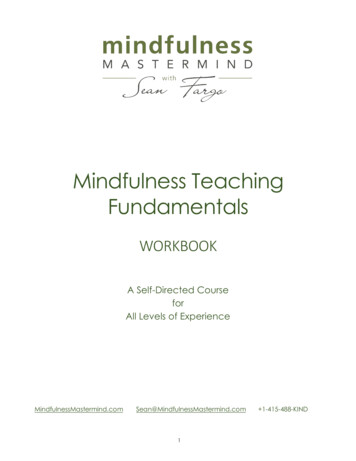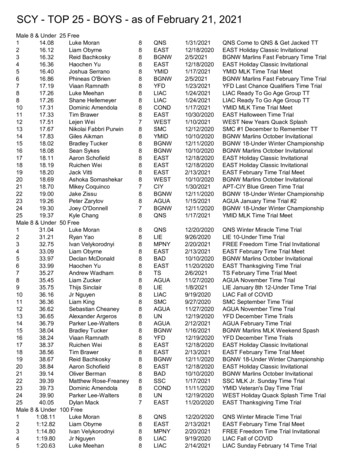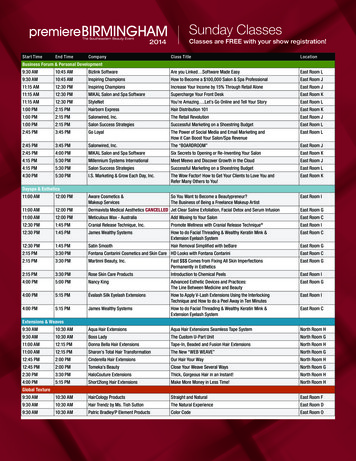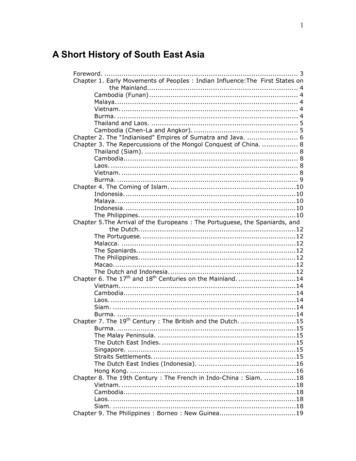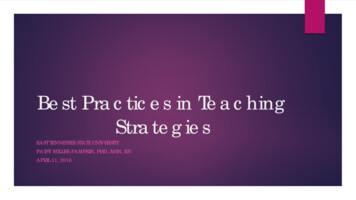
Transcription
Best Practices in TeachingStrategiesEAST TENNESSEE STATE UNIVERSITYPATSY MILLER-PAMPKIN, PHD, MSN, RNAPRIL 11, 2016
Objectives After this presentation, the audience will be able to:1.Identify Core Competencies for Nurse Educators2.Understand characteristics of today’s student learners3.Recognize the value of educational philosophies andlearning theories4.Cognize evidence-based teaching strategies
NLN’s Excellence in Nursing EducationModelThe NLN Excellence in Nursing Education Model comprises eight core elements: A well-prepared faculty Student-centered, interactive, and innovative programs and curricula Evidence-based programs and teaching/evaluation methods Qualified students Clear program standards and hallmarks that raise expectations Means to recognize expertise Quality and adequate resources Well-prepared educational administratorsNLN, 2006
Excellence in Nursing EducationNLN, 2006
NLN, 2006
NLN, 2006
NLN, 2006
NLN, 2006
NLN, 2006
NLN, 2006
NLN, 2006
NLN, 2006
NLN Nurse Educator Core Competencies Competency I: Facilitate LearningNurse educators are responsible for creating an environment in classroom,laboratory, and clinical settings that facilitates student learning and theachievement of desired cognitive, affective, and psychomotor outcomes. Competency II: Facilitate Learner Development and SocializationNurse educators recognize their responsibility for helping students develop asnurses and integrate the values and behaviors expected of those who fulfillthat role. Competency III: Use Assessment and Evaluation StrategiesNurse educators use a variety of strategies to asses and evaluate studentlearning in classroom, laboratory and clinical settings, as well as in all domainsof learning.NLN, 2013
NLN Nurse Educator Core Competencies Competency IV: Participate in Curriculum Design and Evaluation of ProgramOutcomesNurse educators are responsible for formulating program outcomes anddesigning curricula that reflect contemporary health care trends and preparegraduates to function effectively in the health care environment. Competency V: Function as a Change Agent and LeaderNurse educators function as change agents and leaders to create a preferredfuture for nursing education and nursing practice. Competency VI: Pursue Continuous Quality Improvements in the NurseEducator RoleNurse educators recognize that their role is multidimensional and that anongoing commitment to develop and maintain competence in the role isessential.NLN, 2013
NLN Nurse Educator Core Competencies Competency VII: Engage in ScholarshipNurse educators acknowledge that scholarship is an integral componentof the faculty role, and that teaching itself is a scholarly activity. Competency VIII: Function Within the Educational EnvironmentNurse educators are knowledgeable about the educational environmentwithin which they practice and recognize how political, institutional, social,and economic forces impact their role.NLN, 2013
Nursing Education in the ClassroomSetting Characteristics of today’s student learners Ofall ages; Frommany different lifestyles, ethnic, and culturalbackgrounds; Withdifferent generational characteristics; And,most importantly, with different learning styles.(Whittmann-Price, 2013)
Educational Philosophies Positive Environment- must be established for learning to takeplace. Environment must be built on philosophical foundations that: Are never stagnant and change as the larger social system matures Provide the foundations on which learning theories and educationalpedagogies are built Consider the branch of philosophy that addresses why we teach, how weteach, and what the goals of education are for learners and society Date back to Florence Nightingale, who can be credited with the firstnursing education philosophy(Whittmann-Price, 2013)
Educational PhilosophiesTraditional TeachingPhilosophies Teacher-centered Postmodern Philosophies Take into account socialmeaning of learning andthe relationship betweenknowledge and power Consider multiple andinnovative ways of learningBased on what the educatorcould provide to the learner(Whittmann-Price, 2013)
Learning TheoriesLearningTeaching What the educator providesthe learner in terms of goals,methods, objectives, andoutcomes. The processes by which thelearner changes skills,knowledge, and dispositionsthrough a plannedexperience.Whittmann-Price, (2013)
Learning Theories TheoreticalFrameworks Formalizehow people learn and how they store,connect, discover, and retrieve skills and information Tryto explain the connection between knowledgeand the human brain.Whittmann-Price, (2013
Learning Theories Educational Philosophy Guide Learning TheoriesPhilosophies are driven by Metaphysics (the study of what’s real) Epistemology (study of what is truthand knowledge) Axiology (study of what is good) Learning Theories More defined concepts More applicable to teaching situationsthan are philosophies(Whittmann-Price, 2013)
Evidence-Based Teaching Practice Rossetti and Fox (2009) studied interpretive statementsof educators, recognized for excellence, from variousdisciplines and identified four themes in their writteneducational philosophies: Presence, Promotion of learning, Educators as learners, and Enthusiasm.(Whittmann-Price, 2013)
Models Specific to Nursing Carper (1978) described four ways that nurses understand practicesituations:1. Empirical or scientific knowledge (includes evidence-based practice [EBP])2. Personal knowledge or understanding how you would feel in the patient’sposition3. Ethical knowledge or attitudes and understanding of moral decisions4. Aesthetic knowledge or understanding the situation of the patient at the moment Munhall (1993) added the fifth way of knowing: Unknowing or understanding that the nurse cannot know everything about thepatient and must place him- or herself in a position willing(Whittmann-Price, 2013)
Models Specific to Nursing Benner (1982) described five levels of nursing expertise:1.Novice— a beginner with no experience2.Advanced beginner— a person who is at the point of demonstratingacceptable performance3.Competent— typically a nurse with 2 to 3 years’ experience in the samerole4.Proficient— a nurse who perceives and understands situations as a whole5.Expert— a nurse who no longer relies on principles, rules, or guidelines tounderstand patient needs and determine actions(Whittmann-Price, 2013)
Deep, Surface, and Strategic Learning Deep learning approach A learner addresses material with the intent to understand both the conceptsand meaning of the information.Surface learning, or atomistic, approach Memorization of facts and details. Motivation for surface learning, which is primarily extrinsic, is driven by either thelearner’s fear of failing or the desire to complete the course successfully.Strategic learning approach The learner does what is needed to complete a course. S Strategic learning is a mixture of both deep and surface learning techniquesWhittmann-Price, 2013)
Motivational Theories Extrinsic motivation Based on external variables such as grades or earning money.Intrinsic motivation Has to do with the feeling of accomplishment, of learning for the sake oflearning, or the feeling that being a nurse is something the learner alwayswanted to do. Typically, intrinsic motivation is associated with better retention Intrinsic motivation is correlated with Self-Determination Theory According to the theory, humans have three types of needs: To feel competent; Tofeel related ; and To feel autonomousWhittmann-Price, 2013
Motivational Theories ARCS Model Keller (1987) talks about the factors that educatorscan implement to motivate learners in the ARCS model: A— Attention (keeping the learner’s attention through stimuluschanges in the classroom or clinical setting) R— Relevance (make the information relevant to the learner’s goals) C— Confidence (make expectations clear so the learner will engagein learning) S— Satisfaction (have appropriate consequences for the learner’s newskills)Whittmann-Price, 2013
Motivational Theories Brophy Model (1986) listed the following methods bywhich motivation is formed: Modeling Communication of expectations Direct instruction Socialization by parents and educatorsWhittmann-Price, 2013
Motivational Theories Vroom’s Expectancy Model Vroom’s expectancy model (VEM) Describes what people want and whether they are positioned toobtain it. Three concepts:1.1. Force (F)— The amount of effort a person will put into reaching agoal2.2. Valence (V)— How attractive the goal is to the person3.3. Expectancy (E)— The possibility of the goal being achieved The VEM model is F V E (Vroom, 1964).Whittmann-Price, 2013
Motivational Theories DeYoung lists 10 principles to motivate learners:1.Use several senses2.Actively involve the learner3.Assess readiness4.Determine if the learner thinks the information is relevant5.Repeat information6.Generalize information7.Make learning pleasant8.Begin with what is known9.Present information at an appropriate rate10.Provide a learning-friendly environmentWhittmann-Price, 2013
Teaching Styles and rtance of GradesPedagogyThe methods and practices used in teaching The methods and practices used inadults.teaching, especially of children.On independent, self-directed, and/orcooperative learning among adults.On a teacher's methods of transferringknowledge to a student, who is dependenton the teacher's methods andunderstanding.Adults have control over much of theirTeacher controls the learning experience forlearning experience and must be motivatedchildren, and much of what is taught isto learn. Can often seek out new or differentbased on rigid curricula.learning experience, at will.May be very lowHigh
Teaching Styles and EffectivenessQuirk’s Classification of Teaching Styles Assertive— An assertive style is usually content-specific and drives homeinformation. Suggestive— Educator uses experiences to describe a concept and thenrequests the learners research more information on the subject. Collaborative— The educator uses skills to promote problem solving and ahigher level of thinking in the learners. Facilitative— Educators using this style often challenge the learners to reflectand use affective learning. Educators challenge learners to ask ethicalquestions and to demonstrate skill with interpersonal relationships andprofessional behavior.Whittmann-Price, 2013
Teaching Styles and Effectiveness Kelly’s Teaching Effectiveness Kelly (2008) studiedlearners’ perceptions of teaching effectiveness andfound that the most important three attributes were: Teacher knowledge Feedback Communication skillsWhittmann-Price, 2013
Teaching Styles and Effectiveness House, Chassie, and Spohn’s Teaching Behaviors (1999)provide examples of the following behaviors and their effecton learners: Making eye contact can encourage learner participation in class. Positive facial expressions that elicit a positive learner response,such as head nodding, can assist learners in feeling comfortabledialoguing in class, whereas negative gestures, such as frowning,can discourage learner class participation. Vocal tone is very important and can easily portray underlyingfeelings and encourage or discourage learner participation.Whittmann-Price, 2013
Teaching Styles and Effectiveness Choo’s Characteristics of Educators (1996) lists some of the characteristicsof educators that are positive and promote learning: Values learning Exhibits a caring relationship Provides learner independence Facilitates questioning Tries different approaches Accepts the differences among learnersWhittmann-Price, 2013
Teaching Styles and Effectiveness Koshenin’s Positive Teacher– Learner Relationship Attributes (2004) presentsfive themes in the mentoring teacher– learner relationship that can beconceptually transferred into the classroom. They are as follows:1.Worry about the learner’s adjustment2.Experience the pervasiveness of the relationship3.Feel the mutual learning4.Worry about the learning results5.Express disappointment about a lack of cooperation between the school andfield (or the classroom and the larger organization of academia)Whittmann-Price, 2013
Teaching Styles and Effectiveness Hicks and Burkus’s Master Teachers (2011) describeattributes of “master teachers,” which include: Clear communication— oral and written Positive role modeling Professionalism demonstrated in lifelong learning andscholarship Reflective practice and making adjustments for improvement Use of philosophical, epistemological, and ontologicalinfluences in their practice of educationWhittmann-Price, 2013
Teaching Styles and Effectiveness Story and Butts’s Four “Cs” (2010) discuss teaching delivery inthe framework of the important four “Cs”:1.Caring— Learners need to know that educators truly care aboutthem2.Comedy— Used to “demystify” the heavy content proposed tolearners in the classroom3.Creativity— Integrate small creative learning activities such asfood examples and role-play4.Challenge— Maintain high expectations, and the learners willreach themWhittmann-Price, 2013
Teaching Styles and Effectiveness Mann’s 11 Practical Tips (2004): Evaluate the advice of others andbe yourself. Do not use a red pen to correctwork. Write down your expectations. Provide breaks for long classes. Review test answers in writing, ifrequested.Do not change textbooks during acourse. Take roll call to emphasize theimportance of being present.Attend any and all in-services youcan about teaching. Teach to the learners’ level. Set boundaries. Prepare for the next year everyyear.Whittmann-Price, 2013
Learning Outcomes versus LearningObjectivesObjectives An objective speaks to the process,therefore, it is teacher-centered. Nursing educational leaders haverightfully questioned the use ofobjectives within today’s postmoderneducational philosophy environmentbecause: All learning is not displayed in behavior By predetermining objectives oroutcomes, the depth and breadth ofthe learners’ experience may besquashedOutcomes An outcome, on the other hand,speaks to the product, thus, it islearner centered. More general at the institutional leveland more specific at the course level. Learning outcomes will vary dependingon the level for which they are beingdeveloped: the entire school, aprogram, levels within a program, andthe course-specific level.Whittmann-Price, 2013
Critical Thinking and MetacognitionCritical Thinking The rational examination of ideas,inferences, assumptions, principles,arguments, conclusions, issues,statements, beliefs and actions Implicated as an indicator of NCLEXsuccess Lacks data to support the relationship Lack of nursing –specific tools toadequately measure critical thinking inboth beginning and graduating learners.Metacognition An individual’s knowledge, awareness,and command of thinking andlearning strategies Evaluating your own learning andideas and being able to change themto understand and promote your ownlearning successWhittmann-Price, 2013
Evidence-Based Teaching Practice Teaching strategies that enhance critical thinking: Questioning that promotes the evaluation and synthesis of facts Classroom discussions and debates with open negotiation Short, focused writing assignments such as – Summarize five majorpoints in a chapter – Discuss the essence of the chapter using ametaphor – Explain the chapter to your neighbor who has a highschool education – How does the chapter affect your life, personally orprofessionally? Using case studies has also been reported as a learning strategy toincrease critical thinking skillsWhittmann-Price, 2013
Evidence-Based Teaching PracticeAssessing Learners’ Critical Thinking Skills The California Critical ThinkingDisposition Inventory evaluates seven“habits of the mind”: The Watson-Glaser Critical ThinkingAppraisal (1964) has fivesubcategories:1.Truth seeking1.Inference2.Open-mindedness2.Recognition of uisitiveness7.Cognitive maturityWhittmann-Price, 2013
Evidence-Based Teaching Practice Societal mandates insist on quality education mandated through accreditingand governmental agencies with an ever-increasing emphasis on public safety In terms of priorities for funding, there has been a lack of academic recognitionof the value of nursing education research in promotion and tenure criteria The Core Competencies of Nurse Educators, developed by the NLN hasidentified competencies related to scholarship and to the practice ofevidence-based teaching Fostering risk taking and replacing older pedagogies with active learningstrategies Re-envisioning promotion and tenure Fulfilling the university missionWhittmann-Price, 2013
Evidence-Based Teaching Practice Based on four elements:1.Evidence— both quantitative and qualitative2.Professional judgment— nurse educators’ decision-making ability3.Values of learners as clients— using judgment appropriately by getting tounderstand learners4.Resource issues— money, time, and spaceWhittmann-Price, 2013
Learning Activities Passive learning activities do not involve the learner to the extentthat active learning strategies do, but are still in use because theymay be an effective mode for delivering large amounts of content Active teaching strategies are the ones that make a classroomcome alive and engage the learnerWhittmann-Price, 2013
Passive Learning Activities Lectures are rarely used in their pure form, with an educator informinglearners by just speaking to them. Lectures are most often used with audio or visual supplements. Two of the most common visual tools are Microsoft’s PowerPoint and PREZIpresentation software. PowerPoint can be used effectively with graphics, pictures, sounds, and newaudience response systems (clicker) technology to liven up a lecture. Many additional learning activities can also be interspersed within a lecture tocreate a more active environment, such as games, inserted video clips,discussion, and group activityWhittmann-Price, 2013
Lectures Be aware that mild speaking anxiety isnormal Have only two or three learningobjectives per hour Be as prepared as possible Assess the room Use teaching aids (you may know theseas “active learning strategies”) Use plain language whenever possible.(This is important with today’s classes,which may include any number oflearners who speak English as a secondlanguage, or even a third language.) Never memorize Never read word for word Rehearse Think positively If possible, lecture on content that youknow well Show enthusiasm for the subject Do not be authoritarian Watch nonverbal cluesWhittmann-Price, 2013
Lectures Do use examples; these are the basis for case studies Do evaluate your presentation after it ends to make immediateadjustments for next time Don’t hurry Don’t use a lecture if another approach is appropriateWhittmann-Price, 2013
PowerPoint Presentations Limit the number of slides Show images and graphics Use slides with a little information andexpect learners to read Use cartoons Create clinical scenarios Add transitions to slides and audio Ask a colleague to critique it Begin with a question Use current news to introduce a topic Use a feedback lecture format that isa 6- to 10-minute group discussionbetween two 20-minute lecturesWhittmann-Price, 2013
Active Learning Activities Emphasize that learning is a social activity that is best accomplished in aninteractive environment Active learning must be relevant and must assist learners to take part intheir own learning; it must also challenge them to take responsibility fortheir learningWhittmann-Price, 2013
Cooperative/Collaborative Learning Five attributes are needed to make cooperativelearning successful:1.Face-to-face interaction2.Individual and group accountability3.Interpersonal and small-group skills4.Positive interdependence5.Group processingWhittmann-Price, 2013
Self-Directed Learning Consists of a collection of learning activities that are truly learner focused. A process in which the learner decides his or her learning needs. The learner formulates the goals, develops the networking and resources,does the learning, and evaluates the learning.Whittmann-Price, 2013
Reflective Journaling Three-step Process Critical appraisal is journaling done by a learner in a free form to drill down tothe meaning of the clinical experience Peer group discussion shares questions that the learners might have becomeaware of during the journaling process Self-awareness or self-evaluation is the last step and relates journaling to clinicalobjectives for evaluative purposesWhittmann-Price, 2013
Classroom Management1.Encourage contact between learners and educators2.Develop reciprocity and cooperation among learners3.Encourage active learning4.Give prompt feedback5.Emphasize time on task6.Communicate high expectations7.Respect diverse talents and ways of learningWhittmann-Price, 2013
Four Pillars of Classroom Management Pillar 1: Educators should use instructional strategies (active learningstrategies) that motivate and keep learners interested and engaged. Pillar 2: Educators need to use instructional time wisely and take aproactive approach to teaching by charging the learners to beaccountable for their learning. Pillar 3: Social behaviors that need attention and correcting should bedone immediately, face to face, and privately. Pillar 4: Educators need to create a flexible environment to adjust to thelearners’ needs. For example, a learner with attention deficits may be lessdisruptive if placed up front and center.Whittmann-Price, 2013
ReferencesNational League for Nursing. (2006). Excellence model. Retrieved ograms/teachingresources/excellence-modelNational League for Nursing (2013). Nurse educator core competencies.Retrieved from r-corecompetencyWhittmann-Price, R. A (2013). Facilitating leaning in the classroom setting. InWhittmann-Price, R. A., Godshell, M., & Wilson, L. (Eds.). Certified nurseeducator (CNE) review manual (pp. 19-69). New York, NY: SpringerPublishing Company
Apr 11, 2016 · learner’s fear of failing or the desire to complete the course successfully. Strategic learning approach The learner does what is needed to complete a course. S Strategic learning is a mixture of both de


